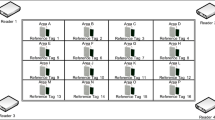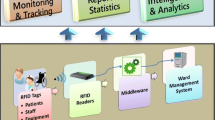Abstract
The economic development and the changes of social demographic structure have resulted in the problems of population aging sharply and elders’ chronic diseases getting serious. Population aging has become a critical problem in modern societies, and senior houses have become a primary option for the life care of elders. However, the regulations related to long-term care are not keeping up with the speed of population aging; also, the lack of caregivers cause the elders not receiving enough care on either outdoor or indoor activities from senior houses. Besides the lack of manpower, an effective healthcare management system is needed to solve the major problem. RFID used to apply on the identification in logistics industry and this technology has become more mature. RFID is now gradually applied to medical business and healthcare for elders. This study intends to replace traditional manual operation with the establishment of RFID positioning monitor and management system in order to reduce manpower as well as continuously transmitting data to the back-end server for real-time monitoring and post enquiry; the data in the database could also become the reference for risk evaluation and healthcare security. Moreover, the system provides not only personal tracker but alerts to secure healthcare so as to reduce chance of accidents happening in nursing homes. The integration of RFID with healthcare operation and information flow is proposed in this study, and the efficient management is also proposed to enhance the management benefits of nursing homes; therefore, this study is focusing on installing the equipment regarding to environment of senior house. The RFID auto positioning monitor system could real-time and continuously monitor and transmit seniors’ physiological signals wirelessly through active RFID Reader and active RFID Tag to promote the quality of healthcare. Besides, the active RFID Tag could be embedded in a wristband with RFID electronic label, tied with elders to receive real-time elders’ body temperature, location, and conditions for the information system. Caregivers in nursing homes therefore could understand the current situation of elders and monitor the seniors’ situations to prevent accidents.






Similar content being viewed by others
References
Chen, Y. S. (2005). Design and implementation of an open system platform for nursing home medical information system (pp. 1–75). Taichung: Asia University Department of Computer Science and Engineering.
Akyildiz, I. F., Su, W., Sankarasubramaniam, Y., & Cyirci, E. (2002). A survey on sensor networks. IEEE Communications Magazine, 40(8), 102–114.
Abdo, I., Odeh, M.. & Shahroury, F. R. (2013). A new modulation scheme for low power consumption and small size passive RFID tags. In 2013 IEEE conference on wireless sensor (ICWISE) (pp. 68–72).
Hong, S. S. B., Ibrahim, R. B., Khir, M. H. M., Zakariya, M. A. B., & Daud, H. (2013). Wi-Fi energy harvester for low power RFID application. Progress In Electromagnetics Research C, 40, 69–81.
Chouhan, S. S., & Halonen, K. (2013). A simple all MOS voltage reference for RFID applications. In 2013 IEEE conference on NORCHIP (pp. 1–3).
McCarthy, J. F., Nguyen, D. H., Rashid, A. M., & Soroczak, S. (2002). Proactive displays and the experience UbiComp project. ACM SIGGROUP Bulletin, 23(3), 38–41.
Timalsina, S. K., Bhusal, R., & Moh, S. (2012). NFC and its application to mobile payment: Overview and comparison. International Conference on Information Science and Digital Content Technology (ICIDT), 1, 203–206.
Hu, R. S., & Li, D. S. (2012). RFID system and EPC global architecture framework. Taipei: National Taiwan University Publishing Center.
Domdouzis, K., Kumar, B., & Anumba, C. (2007). Radio-frequency identification (RFID) applications: A brief introduction. Advanced Engineering Informatics, 21, 350–355.
Bassi, R. (1996). ICT carrier programmed—Output 21: Technology review, knowledge division. Bracknell: BRE.
Roberts, C. M. (2006). Radio frequency identification (RFID). Computers and Security, 25(1), 18–26.
Landt, J. (2005). The history of RFID. IEEE Potentials, 24(4), 8–11.
Ashokkumar, A. S. (2014). RFID: An emerging technology for libraries. Asian Journal of Multidisciplinary Studies, 2(7), 43–46.
Zhao, Y., Gao, X., & Wu, S. (2013). An algorithm for routes recommendation service based on the radio-frequency identification application. In IFSA world congress and NAFIPS annual meeting (IFSA/NAFIPS) (pp. 748–753).
Sheng, Q. Z., Zeadally, S., Mitrokotsa, A., & Maamar, Z. (2011). RFID technology, systems, and applications. Journal of Network and Computer Applications, 34, 797–798.
Chen, J. C., Cheng, C. H., & Huang, P. B. (2013). Supply chain management with lean productionand RFID application: A case study. Expert Systems with Applications, 40(9), 3389–3397.
Wu, C. C., Yu, K. M., Chine, S. T., & Cheng, S. T. (2013). An intelligent active alert application on handheld devices for emergency evacuation guidance. In 2013 Fifth international conference on ubiquitous and future networks (ICUFN) (pp. 7–11).
Hu, Y., Dai, H., & Jiang, B. (2010). Design and implementation of the base transceiver station routing inspection system based on RFID. In 2010 IEEE international conference on RFID-technology and applications (RFID-TA) (pp. 81–85).
Alemdar, H., & Ersoy, C. (2010). Wireless sensor networks for healthcare: A survey. Computer Networks, 54(15), 2688–2710.
Pandian, P. S., Mohanavelu, K., Safeer, K. P., Kotresh, T. M., Shakunthala, D. T., Gopal, P., et al. (2008). Smart vest: Wearable multi-parameter remote physiological monitoring system. Medical Engineering & Physics, 30(4), 466–477.
Rotter, P., Daskala, B., & Compano, R. (2008). RFID implants: Opportunities and challenges for identifying people. IEEE on Technology and Society Magazine, 27(2), 24–32.
AFCEA. (2005). Radio frequency identification ready to deliver. Signal Magazine, Armed Forces Communications and Electronics Association (AFCEA). http://www.afcea.org/.
Eungyeong, K., Hyogun, Y., Yupeng, Z., Lee, M., & Jaewan, L. (2008). A hypertension management system with emergency monitoring. Information Security and Assurance, 301–306.
Downton, J. H. (1993). Falls in the Elderly. London: Edward Arnold.
Wang, C. C., & Chen, Y. C. (2007). RFID emergency notification system for fall accidents at home. In Proceedings of 9th international conference on e-health networking, application and services (pp. 323–326).
Lu, B. K. (2007). A service oriented information system for long-term care (pp. 1–166). Taoyuan: Chang Gung University Department of Computer Science and Engineering.
Mateska, A., Pavloski, M., & Gavrilovska, L. (2011). RFID and sensors enabled in-home elderly care. In 34th international convention on MIPRO (pp. 285–290).
Blumenthal, J., Grossmann, R., Golatowski, F., & Timmermann, D. (2007). Weighted centroid localization in zigbee-based sensor networks (pp. 1–6). WISP: IEEE International Symposium on Intelligent Signal Processing.
Wu, S. X. (2008). A 3D virtual tour system supported RFID localization (pp. 1–54). New Taipei City: Aletheia University Department of Mathematical Sciences.
Author information
Authors and Affiliations
Corresponding author
Rights and permissions
About this article
Cite this article
Liao, YT., Chen, TL., Chen, TS. et al. The Application of RFID to Healthcare Management of Nursing House. Wireless Pers Commun 91, 1237–1257 (2016). https://doi.org/10.1007/s11277-016-3525-0
Published:
Issue Date:
DOI: https://doi.org/10.1007/s11277-016-3525-0




